
Risotto is an Italian rice dish cooked with broth until it reaches a creamy consistency. The broth can be derived from meat, fish, or vegetables. Many types of risotto contain butter, onion, white wine, and Parmesan cheese. It is one of the most common ways of cooking rice in Italy. Saffron was originally used for flavour and its signature yellow colour.

Calzone is an Italian oven-baked turnover, made with leavened dough. It originated in Naples in the 18th century. A typical calzone is made from salted bread dough, baked in an oven and stuffed with salami, ham or vegetables, mozzarella, ricotta and Parmesan or pecorino cheese, as well as an egg. Different regional variations in or on a calzone can often include other ingredients that are normally associated with pizza toppings. The term usually applies to an oven-baked turnover rather than a fried pastry, though calzoni and panzerotti are often mistaken for each other.

Ossobuco or osso buco is a specialty of Lombard cuisine of cross-cut veal shanks braised with vegetables, white wine, and broth. It is often garnished with gremolata and traditionally served with either risotto alla milanese or polenta, depending on the regional variation. The marrow in the hole in the bone, a prized delicacy, is the defining feature of the dish.
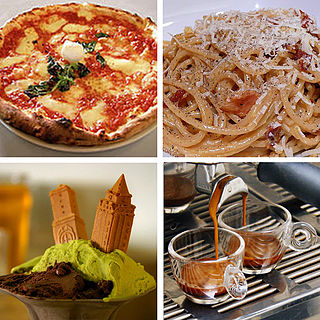
Italian cuisine is a Mediterranean cuisine consisting of the ingredients, recipes and cooking techniques developed in Italy since Roman times and later spread around the world together with waves of Italian diaspora. Some of these foods were imported from other cultures. Significant changes occurred with the colonization of the Americas and the introduction of potatoes, tomatoes, capsicums, maize and sugar beet—the latter introduced in quantity in the 18th century. It is one of the best-known and most appreciated gastronomies worldwide.

Ribollita is a Tuscan bread soup, panade, porridge or potage made with bread and vegetables, often from leftovers. There are many variations, but the usual ingredients include leftover bread, cannellini beans, lacinato kale, cabbage and inexpensive vegetables such as carrot, beans, chard, celery, potatoes and onion. It is often baked in a clay pot.

Piccata is an Italian dish of thin pan-fried flour-dredged meat in a sauce of lemon juice, butter, parsley, and often capers. In Italian cuisine piccata is prepared using veal, whereas in Italian-American cuisine, chicken is more commonly used. A similar dish, pesce spada con capperi e limone, is made with swordfish.

Italian meal structure is typical of the European Mediterranean region and differs from Northern, Central, and Eastern European meal structure, though it still often consists of breakfast (colazione), lunch (pranzo), and supper (cena). However, much less emphasis is placed on breakfast, and breakfast itself is often skipped or involves lighter meal portions than are seen in non-Mediterranean Western countries. Late-morning and mid-afternoon snacks, called merenda, are also often included in this meal structure.

Sgabeo is a food typical of Lunigiana, an Italian historical region now divided between Liguria and Tuscany. This is leavened bread dough, cut into strips, fried and salted on the surface that is traditionally eaten plain or stuffed with cheese or cold cuts. Lately, however, it is not uncommon that the sgabeo is also proposed as a sweet, filled with pastry cream or chocolate.
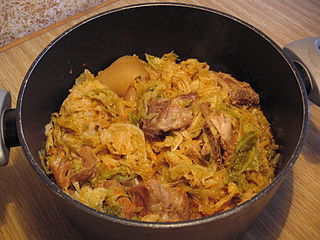
Lombard cuisine is the style of cooking in the Northern Italian region of Lombardy. The historical events of its provinces and of the diversity of its territories resulted in a varied culinary tradition. First courses in Lombard cuisine range from risottos to soups and stuffed pasta, and a large choice of second course meat or fish dishes, due to the many lakes and rivers of Lombardy.
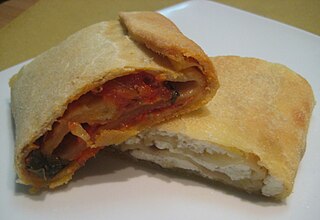
Scaccia, scacciata or schiacciata is a Sicilian stuffed flatbread. Scaccia is made with a very thin rectangular layer of dough, folded on itself three or four times. It can be stuffed with different ingredients, the more common variations are ricotta cheese and onion, cheese and tomato, tomato and onion, or tomato and eggplant, depending on location, taste, or season. It is baked and can be eaten hot or cold. Scacciata derives from the Sicilian word meaning to drive away, equivalent to the Italian word schiacciata, meaning 'to crush' or 'to flatten'. Scaccia can be found in Ragusa and Siracusa, as well as some Sicilian American communities.
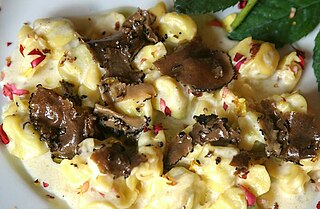
Fagottini is a kind of filled pasta. It is usually filled with vegetables, typically steamed carrots and green beans, ricotta, onion and olive oil. Fagottini are made by cutting sheets of pasta dough into squares, placing the filling on the square, and folding the corners to meet in a point.
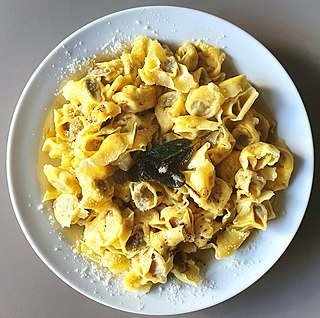
Agnolini are a type of egg-based stuffed pasta originating in the province of Mantua, Italy. it is often eaten in soup or broth.

Ligurian cuisine consists of dishes from the culinary tradition of Liguria, a region of northwestern Italy, which makes use of ingredients linked both to local production, and to imports from areas with which, over the centuries, the Ligurians have had frequent trade.

The cuisine of Basilicata, or Lucanian cuisine, is the cuisine of the Basilicata region of Italy. It is mainly based on the use of pork and sheep meat, legumes, cereals and vegetables, with the addition of aromas such as hot peppers, powdered raw peppers and horseradish. The local gastronomy is, for historical-cultural reasons, typically peasant, based on simple recipes and on the culture of reuse, in particular of meat and bread.

Mantuan cuisine is the set of traditional dishes of the Italian province of Mantua, some of which date back to the time of the Gonzaga.
Pancotto is a soup prepared with pieces of stale bread boiled in broth or water and seasoned.
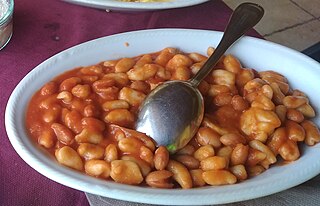
Pisarei e faśö, also called pisarei cui faśö, are a typical pasta dish of the Italian province of Piacenza, among the best known of Piacenza cuisine. These are small gnocchi made of flour and breadcrumbs served with a sauce made of beans, lard, onion and tomato. An ancient peasant recipe, poor but complete, still today it is very popular among the people and in the restaurants of Piacenza.
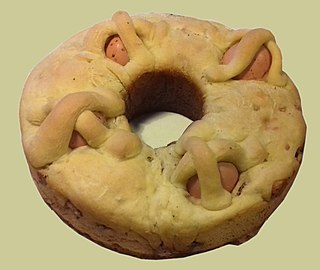
Casatiello is a leavened savory bread originating from Naples prepared during the Easter period.

Cappelletti are ring-shaped stuffed pasta so called for the characteristic shape that resembles a hat. Compared to tortellini, they have a different shape, larger size, thicker dough and different filling.















